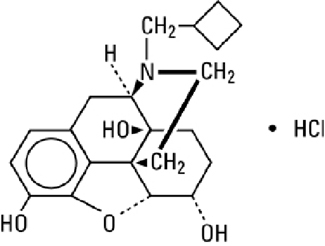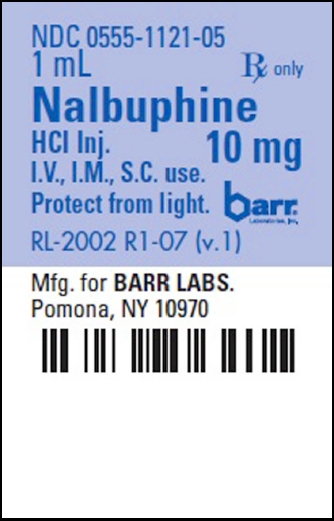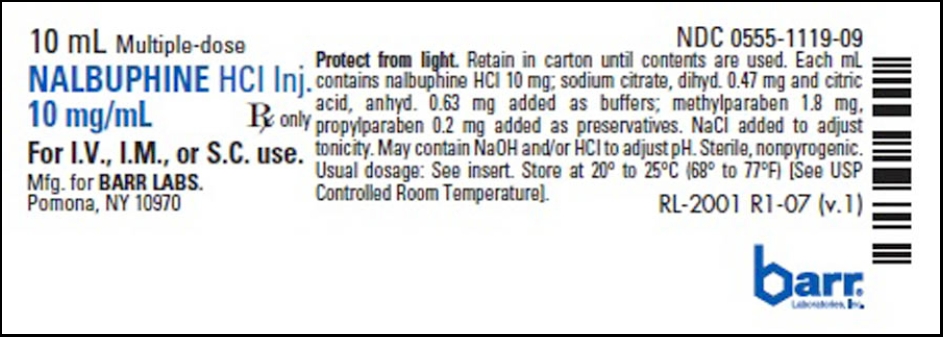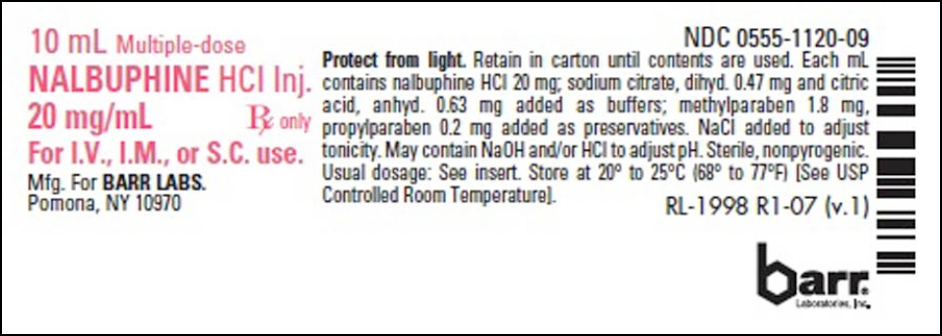NALBUPHINE HYDROCHLORIDE
-
nalbuphine hydrochloride injection, solution
Barr Laboratories, Inc.
----------
DESCRIPTION
Nalbuphine Hydrochloride Injection is a sterile, nonpyrogenic solution of nalbuphine hydrochloride in water for injection. This product may be administered by subcutaneous, intramuscular or intravenous injection.
Each milliliter (mL) contains nalbuphine hydrochloride 10 mg or 20 mg; sodium citrate, dihydrate 0.47 mg and citric acid, anhydrous 0.63 mg added as buffers and may contain sodium hydroxide and/or hydrochloric acid for pH adjustment; pH 3.7 (3.0 to 4.5). Contains sodium chloride for tonicity adjustment.
Multiple-dose vials contain 1.8 mg/mL methylparaben and 0.2 mg/mL propylparaben added as preservatives. Single-dose products contain no bacteriostat or antimicrobial agent and unused portions must be discarded.
Nalbuphine hydrochloride is a synthetic narcotic agonist-antagonist analgesic of the phenanthrene series chemically designated (-) -17 (cyclobutylmethy)-4, 5α-epoxymorphinan-3, 6α,14 triol, hydrochloride. It is chemically related to both the widely used narcotic antagonist, naloxone, and the potent narcotic analgesic, oxymorphone, and has the following molecular and structural formula:

M.W. 393.91
(C21H27NO4 • HCl)
CLINICAL PHARMACOLOGY
Nalbuphine hydrochloride is a potent analgesic. Its analgesic potency is essentially equivalent to that of morphine on a milligram basis.
Its onset of action occurs within 2 to 3 minutes after intravenous administration, and in less than 15 minutes following subcutaneous or intramuscular injection. The plasma half-life of nalbuphine is 5 hours and in clinical studies the duration of analgesic activity has been reported to range from 3 to 6 hours.
The narcotic antagonist activity of nalbuphine is one-fourth as potent as nalorphine and 10 times that of pentazocine.
INDICATIONS AND USAGE
Nalbuphine hydrochloride is indicated for the relief of moderate to severe pain. Nalbuphine hydrochloride can also be used as a supplement to balanced anesthesia, for preoperative and postoperative analgesia, and for obstetrical analgesia during labor and delivery.
CONTRAINDICATIONS
Nalbuphine hydrochloride injection should not be administered to patients who are hypersensitive to it.
WARNINGS
Nalbuphine hydrochloride injection should be administered as a supplement to general anesthesia only by persons specifically trained in the use of intravenous anesthetics and management of respiratory effects of potent opioids.
Naloxone hydrochloride injection, resuscitative and intubation equipment and oxygen should be readily available.
Drug Dependence: Nalbuphine has been shown to have a low abuse potential. When compared with drugs which are not mixed agonist-antagonists, it has been reported that nalbuphine’s potential for abuse would be less than that of codeine and propoxyphene. Psychological and physical dependence and tolerance may follow the abuse or misuse of nalbuphine. Therefore, caution should be observed in prescribing it for emotionally unstable patients, or for individuals with a history of narcotic abuse. Such patients should be closely supervised when long-term therapy is contemplated.
Care should be taken to avoid increases in dosage or frequency of administration which in susceptible individuals might result in physical dependence.
Abrupt discontinuation of Nalbuphine Hydrochloride following prolonged use has been followed by symptoms of narcotic withdrawal, i.e., abdominal cramps, nausea and vomiting, rhinorrhea, lacrimation, restlessness, anxiety, elevated temperature and piloerection.
Use in Ambulatory Patients: Nalbuphine may impair the mental or physical abilities required for the performance of potentially dangerous tasks such as driving a car or operating machinery. Therefore, Nalbuphine Hydrochloride Injection should be administered with caution to ambulatory patients who should be warned to avoid such hazards.
Use in Emergency Procedures: Maintain patient under observation until recovered from nalbuphine effects that would affect driving or other potentially dangerous tasks.
Use in Pediatrics: Clinical experience to support administration to patients under 18 years is not available at present.
Use in Pregnancy (other than labor): Safe use of nalbuphine hydrochloride in pregnancy has not been established. Although animal reproductive studies have not revealed teratogenic or embryotoxic effects, nalbuphine should only be administered to pregnant women when, in the judgment of the physician, the potential benefits outweigh the possible hazards.
Use During Labor and Delivery: Nalbuphine can produce respiratory depression and cardiac rhythm disturbances in the neonate. It should be used with caution in women during labor and delivery, and newborns should be monitored for respiratory depression, apnea, bradycardia and arrhythmias if nalbuphine has been used.
Head Injury and Increased Intracranial Pressure: The possible respiratory depressant effects and the potential of potent analgesics to elevate cerebrospinal fluid pressure (resulting from vasodilation following CO2 retention) may be markedly exaggerated in the presence of head injury, intracranial lesions or a pre-existing increase in intracranial pressure. Furthermore, potent analgesics can produce effects which may obscure the clinical course of patients with head injuries. Therefore, Nalbuphine Hydrochloride Injection should be used in these circumstances only when essential, and then should be administered with extreme caution.
Interaction With Other Central Nervous System Depressants: Although nalbuphine possesses narcotic antagonist activity, there is evidence that in nondependent patients it will not antagonize a narcotic analgesic administered just before, concurrently, or just after an injection of nalbuphine hydrochloride. Therefore, patients receiving a narcotic analgesic, general anesthetics, phenothiazines, or other tranquilizers, sedatives, hypnotics, or other CNS depressants (including alcohol) concomitantly with nalbuphine may exhibit an additive effect. When such combined therapy is contemplated, the dose of one or both agents should be reduced.
PRECAUTIONS
Impaired Respiration: At the usual adult dose of 10 mg/70 kg, nalbuphine hydrochloride causes some respiratory depression approximately equal to that produced by equal doses of morphine. However, in contrast to morphine, respiratory depression is not appreciably increased with higher doses of nalbuphine. Respiratory depression induced by nalbuphine can be reversed by naloxone hydrochloride when indicated. Nalbuphine Hydrochloride Injection should be administered with caution at low doses to patients with impaired respiration (e.g., from other medication, uremia, bronchial asthma, severe infection, cyanosis or respiratory obstructions).
Impaired Renal or Hepatic Function: Because nalbuphine is metabolized in the liver and excreted by the kidneys, patients with renal or liver dysfunction may overreact to customary doses. Therefore, in these individuals, Nalbuphine Hydrochloride Injection should be used with caution and administered in reduced amounts.
Myocardial Infarction: As with all potent analgesics, nalbuphine hydrochloride should be used with caution in patients with myocardial infarction who have nausea or vomiting.
Biliary Tract Surgery: As with all narcotic analgesics, nalbuphine hydrochloride should be used with caution in patients about to undergo surgery of the biliary tract since it may cause spasm of the sphincter of Oddi.
Cardiovascular System: During evaluation of Nalbuphine Hydrochloride Injection, in anesthesia, a higher incidence of bradycardia has been reported in patients who did not receive atropine preoperatively or in the preoperative period.
ADVERSE REACTIONS
The most frequent adverse reaction in 1066 patients treated with Nalbuphine Hydrochloride Injection is sedation 381 (36%). Less frequent reactions are: sweaty/clammy 99 (9%), nausea/vomiting 68 (6%), dizziness/vertigo 58 (5%), dry mouth 44 (4%), and headache 27 (3%).
Other adverse reactions which may occur (reported incidence of 1% or less) are:
CNS Effects: Nervousness, depression, restlessness, crying, euphoria, floating, hostility, unusual dreams, confusion, faintness, hallucinations, dysphoria, feeling of heaviness, numbness, tingling, unreality. The incidence of psychotomimetic effects, such as unreality, depersonalization, delusions, dysphoria and hallucinations has been shown to be less than that which occurs with pentazocine.
Cardiovascular: Hypertension, hypotension, bradycardia, tachycardia.
Gastrointestinal: Cramps, dyspepsia, bitter taste.
Respiration: Depression, dyspnea, asthma.
Dermatological: Itching, burning, urticaria.
Miscellaneous: Speech difficulty, urinary urgency, blurred vision, flushing and warmth.
OVERDOSAGE
Management of Overdosage: The immediate intravenous administration of naloxone hydrochloride is a specific antidote. Oxygen, intravenous fluids, vasopressors and other supportive measures should be used as indicated.
The administration of single doses of 72 mg of nalbuphine hydrochloride subcutaneously to eight normal subjects has been reported to have resulted primarily in symptoms of sleepiness and mild dysphoria.
DOSAGE AND ADMINISTRATION
The usual recommended adult dose is 10 mg for a 70 kg individual administered subcutaneously, intramuscularly, or intravenously; this dose may be repeated every 3 to 6 hours as necessary. Dosage should be adjusted according to the severity of the pain, physical status of the patient, and other medications which the patient may be receiving (see Interaction With Other Central Nervous System Depressants under WARNINGS). In nontolerant individuals, the recommended single maximum dose is 20 mg with a maximum total daily dose of 160 mg.
The use of Nalbuphine Hydrochloride Injection as a supplement to balanced anesthesia requires larger doses than those recommended for analgesia. Induction doses of nalbuphine hydrochloride range from 0.3 mg/kg to 3.0 mg/kg intravenously to be administered over a 10 to 15 minute period with maintenance doses of 0.25 to 0.50 mg/kg in single intravenous administrations as required. The use of Nalbuphine Hydrochloride Injection may be followed by respiratory depression which can be reversed with the narcotic antagonist naloxone hydrochloride.
Patients Dependent on Narcotics: Patients who have been taking narcotics chronically may experience withdrawal symptoms upon the administration of nalbuphine hydrochloride injection. If unduly troublesome, narcotic withdrawal symptoms can be controlled by the slow intravenous administration of small increments of morphine, until relief occurs. If the previous analgesic was morphine, meperidine, codeine, or other narcotic with similar duration of activity, one-fourth of the anticipated dose of nalbuphine hydrochloride can be administered initially and the patient observed for signs of withdrawal, i.e., abdominal cramps, nausea and vomiting, lacrimation, rhinorrhea, anxiety, restlessness, elevation of temperature or piloerection. If untoward symptoms do not occur, progressively larger doses may be tried at appropriate intervals until the desired level of analgesia is obtained with nalbuphine hydrochloride.
Parenteral drug products should be inspected visually for particulate matter and discoloration prior to administration whenever solution and container permit.
HOW SUPPLIED
Nalbuphine Hydrochloride Injection is supplied as follows:
|
NDC No. |
Container |
Size (mL) |
mg/mL |
Total mg |
|
0555-1121-05 |
Ampul |
1 |
10 |
10 |
|
0555-1122-05 |
Ampul |
1 |
20 |
20 |
|
0555-1119-09 |
Fliptop Vial (multiple-dose) |
10 |
10 |
100 |
|
0555-1120-09 |
Fliptop Vial (multiple-dose) |
10 |
20 |
200 |
Store at 20° to 25°C (68° to 77°F) [See USP Controlled Room Temperature].
Protect from light.
Revised: January, 2007 (v.1)
EN-1439
Manufactured by Hospira, Inc.
Lake Forest, IL 60045 for
BARR LABORATORIES, INC.
Pomona, NY 10970
| NALBUPHINE HYDROCHLORIDE
nalbuphine hydrochloride injection, solution |
||||||||||||||||||
|
||||||||||||||||||
|
||||||||||||||||||
|
||||||||||||||||||
|
||||||||||||||||||
|
||||||||||||||||||
| Marketing Information | |||
| Marketing Category | Application Number or Monograph Citation | Marketing Start Date | Marketing End Date |
| ANDA | ANDA070914 | 05/19/1998 | 03/31/2011 |
| NALBUPHINE HYDROCHLORIDE
nalbuphine hydrochloride injection, solution |
||||||||||||||||||
|
||||||||||||||||||
|
||||||||||||||||||
|
||||||||||||||||||
|
||||||||||||||||||
|
||||||||||||||||||
| Marketing Information | |||
| Marketing Category | Application Number or Monograph Citation | Marketing Start Date | Marketing End Date |
| ANDA | ANDA070916 | 05/19/1998 | 02/28/2011 |
| NALBUPHINE HYDROCHLORIDE
nalbuphine hydrochloride injection, solution |
||||||||||||||||||||
|
||||||||||||||||||||
|
||||||||||||||||||||
|
||||||||||||||||||||
|
||||||||||||||||||||
|
||||||||||||||||||||
| Marketing Information | |||
| Marketing Category | Application Number or Monograph Citation | Marketing Start Date | Marketing End Date |
| ANDA | ANDA070915 | 05/19/1998 | 04/30/2011 |
| NALBUPHINE HYDROCHLORIDE
nalbuphine hydrochloride injection, solution |
||||||||||||||||||||
|
||||||||||||||||||||
|
||||||||||||||||||||
|
||||||||||||||||||||
|
||||||||||||||||||||
|
||||||||||||||||||||
| Marketing Information | |||
| Marketing Category | Application Number or Monograph Citation | Marketing Start Date | Marketing End Date |
| ANDA | ANDA070918 | 05/19/1998 | 11/30/2010 |
| Labeler - Barr Laboratories, Inc. (802716563) |
Revised: 09/2012 Barr Laboratories, Inc.



